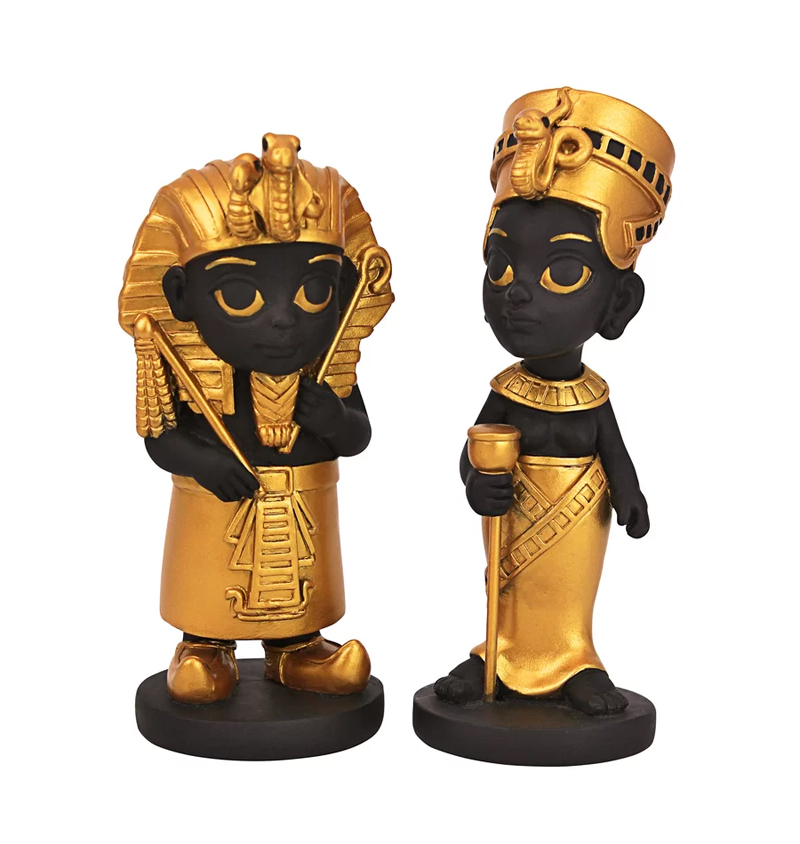Pharaoh and Great Royal Wife Rulers of the Ancient Egyptian Kingdom (Black & Gold) Statues
If legend tells tales of tiny, supernatural wee ones who inhabited a magical kingdom beneath the surface of the earth, who are we to argue? These Pharaoh and Great Royal Wife Statues could well have been the very entities who wielded sword and scepter in the tiny dynasties of Ancient Egypt. Cast in quality designer resin to capture tongue-in-cheek details from ornate headdresses to hieroglyphs, each wee sculpture is hand painted with gold-toned details and the colors of the Egyptian palette. Pharaoh is the common title now used for the monarchs of ancient Egypt from the First Dynasty (3150 BCE) until the annexation of Egypt by the Roman Empire in 30 BCE, although the term “pharaoh” was not used contemporaneously for a ruler until Merneptah, (1210 BCE), during the 19th dynasty, “king” being the term used most frequently until the middle of the 18th dynasty. In the early dynasties, Ancient Egyptian Kings used to have up to three titles: the Horus, the Sedge and Bee, and the Two Ladies or Nebty name.
The Golden Horus as well as the nomen and prenomen titles were added later. In Egyptian society, religion was central to everyday life. One of the roles of the pharaoh was as an intermediary between the deities and the people. The pharaoh thus deputised for the deities in a role that was both as civil and religious administrator. The pharaoh owned all of the land in Egypt, enacted laws, collected taxes, and defended Egypt from invaders as the commander-in-chief of the army. Religiously, the Pharaoh officiated over religious ceremonies and chose the sites of new temples. The pharaoh was responsible for maintaining Maat, or cosmic order, balance, and justice, and part of this included going to war when necessary to defend the country or attacking others when it was believed that this would contribute to Maat, such as to obtain resources. During the early days prior to the unification of Upper and Lower Egypt, the Deshret or the “Red Crown“, was a representation of the kingdom of Lower Egypt, while the Hedjet, the “White Crown“, was worn by the kings of the kingdom of Upper Egypt.
After the unification of both kingdoms into one united Egypt, the Pschent, the combination of both the red and white crowns was the official crown of kings. With time new headdresses were introduced during different dynasties such as the Khat, Nemes, Atef, Hemhem crown, and Khepresh. At times, it was depicted that a combination of these headdresses or crowns that would be worn together. Great Royal Wife, or alternatively, Chief King’s Wife, is the title that was used to refer to the principal wife of the pharaoh of Ancient Egypt, who served many official functions. While most ancient Egyptians were monogamous, a male pharaoh would have had other, lesser wives and concubines in addition to the Great Royal Wife. This arrangement would allow the pharaoh to enter into diplomatic marriages with the daughters of allies, as was the custom of ancient kings. In the past the order of succession in Ancient Egypt was to pass through the royal women. This theory, referred to as the Heiress Theory, has been rejected regarding the 18th dynasty ever since a 1980s study of its royalty. The throne likely passed to the eldest living son of those pharaohs.
The mother of the heir to the throne was not always the Great Royal Wife, but once a pharaoh was crowned, it was possible to grant the mother of the king the title of Great Royal Wife, along with other titles. Examples include Iset, the mother of Thutmose III, Tiaa, the mother of Thutmose IV and Mutemwia, the mother of Amenhotep III. Meretseger, the chief wife of Senusret III, may be the earliest queen whose name appears with this title, she also was the first consort known to write her name in a cartouche. However, she is only attested in the New Kingdom so the title might be an anachronism. Perhaps the first holder of its title was Nubkhaes of the Second Intermediate Period. The royal women also played a pivotal role in the religion of ancient Egypt. The Great Royal Wife officiated at the rites in the temples, as Priestess, in a culture where religion was inexorably interwoven with the roles of the rulers. Rulers of the Ancient Egyptian Kingdom (Black & Gold) Statue sizes: 2.5 inches / 6.5 cm x 2.5 inches / 6.5 cm x 6 inches / 15 cm.
Pharaoh and Great Royal Wife Statues on Amazon.
Pharaoh and Great Royal Wife Statues on eBay.



